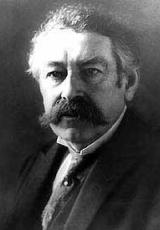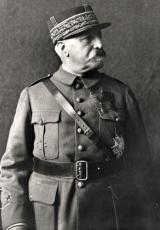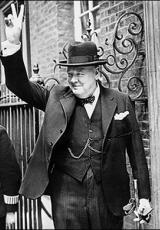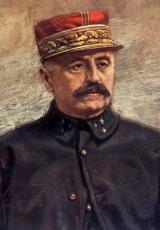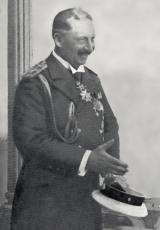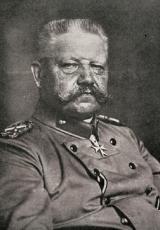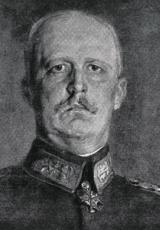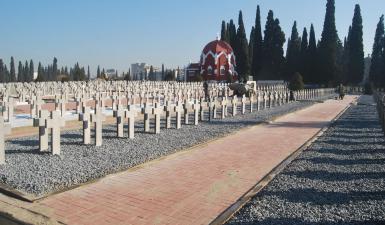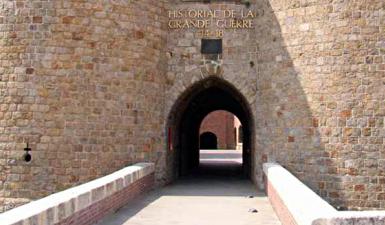The year 1915 – Putting an end to the trenches

Contents
6 janvier : victoires russes sur les Turcs dans le Caucase.
19 janvier : raid aérien de zeppelins sur la côte anglaise.
21 janvier : offensive russe dans les Carpates.
24 janvier : victoire de la flotte britannique près du Dogger Bank sur l'escadre allemande.
26 janvier : offensive turque contre les troupes britanniques, sur le canal de Suez, en Égypte.
3 février : défaite de l?Empire ottoman face aux britanniques en Égypte.
4 février : offensive allemande à l?Est : évacuation de la Prusse orientale par les Russes . les eaux territoriales britanniques déclarées "zone de guerre" par l?Allemagne : début de la guerre sous-marine.
7 février : offensive allemande au sud-est des lacs Mazures.
16 février : début de l'offensive franco-britannique en Champagne.
17février : combats aux Éparges.
26 février : échec de l'offensive allemande aux lacs Mazures.
1er mars : blocus général contre l'Allemagne.
16 mars : fin de la bataille de Champagne, échec de la tentative de percée française.
18 mars : échec de l?attaque navale des Alliés sur les Dardanelles, en Turquie.
21-22 mars : raids aériens de zeppelins sur Paris.
22 mars : succès russes en Pologne face aux Autrichiens, capitulation de Przemysl.
2 avril : vote de la loi instituant la Croix de guerre.
5 avril : offensive française en Meuse et en Moselle.
6 avril : combats aux Eparges.
22 avril : deuxième bataille d?Ypres . première utilisation de gaz asphyxiants, à l?Ouest, par les Allemands.
24 avril : massacres et déportations d'Arméniens par les Turcs.
25 avril : débarquement allié sur la presqu?île de Gallipoli, à l?entrée du détroit des Dardanelles, en Turquie.
26 avril : signature du traité de Londres entre les Alliés et l'Italie.
2 mai : offensive austro-allemande en Galicie : recul de l'armée russe le 7.
7 mai : torpillage du paquebot britannique Lusitania.
9 mai-15 juin : seconde bataille d?Artois.
11 mai : attaque de l'Afrique Orientale allemande par les Alliés.
15 mai : défaite des Russes dans les Carpates.
20 mai : capitulation de la Chine face au Japon.
23 mai : avancée anglaise en Mésopotamie . déclaration de guerre de l'Italie à l'Autriche-Hongrie.
3 juin : rupture du front russe en Galicie : évacuation de Przemysl par les troupes russes.
10 juin : offensive italienne sur l'Isonzo contre les lignes autrichiennes.
11 juin : invasion de l?Albanie par les troupes serbes . occupation de Tirana.
19 juin : bataille d'Artois.
22 juin : percée allemande en Russie.
23 juin : attaque italienne contre les troupes austro-hongroises sur l'Isonzo.
7 juillet : première conférence interalliée à Chantilly visant à coordonner les offensives sur les fronts Ouest, italien et Serbe.
9 juillet : capitulation allemande en Afrique du Sud.
13 juillet : reprise de l?offensive allemande en Pologne.
18 juillet : échec italien de la deuxième offensive sur l'Isonzo.
4 août : entrée des Allemands à Varsovie.
21 août : déclaration de guerre de l?Italie à la Turquie.
26 août : prise de Brest-Litovsk par les troupes allemandes.
6 septembre : signature d?un traité d?alliance entre la Bulgarie et les Empires centraux.
10 septembre : lancement du journal Le Canard enchaîné.
22 septembre : mobilisation en Grèce et en Bulgarie.
25 septembre : offensive alliée en Artois et en Champagne.
5 octobre : entrée en guerre de la Bulgarie aux côtés des Empires centraux . débarquement des premiers éléments du corps expéditionnaire allié à Salonique.
6 octobre : offensive germano-austro-bulgare contre la Serbie.
7 octobre : chute de Belgrade.
9 octobre : débarquement des forces franco-britanniques à Salonique.
16-19 octobre : déclaration de guerre de l'Angleterre, de la France, de l'Italie et de la Russie à la Bulgarie.
18 octobre : troisième bataille de l'Isonzo.
27 octobre : proclamation de sa neutralité par la Grèce.
Offensive autrichienne en Bucovine . invasion de la Serbie et du Monténégro.
10 novembre : quatrième offensive italienne sur l'Isonzo.
23 novembre : retraite de l'armée serbe vers l'Albanie avant son évacuation vers Corfou.
2 décembre : Joffre commandant en chef des armées françaises . ordre de repli au-delà du Vardar aux troupes alliées de Salonique.
6-8 décembre : conférence interalliée de Chantilly convenant d?une offensive simultanée sur tous les fronts en juin suivant.
10 décembre : échec de l'expédition des Dardanelles . début des opérations de rembarquement des troupes alliées de Gallipoli.
27 décembre : remplacement de French par Haig à la tête du corps expéditionnaire britannique.
29 décembre : le général Sarrail nommé commandant en chef de l?armée d?Orient.


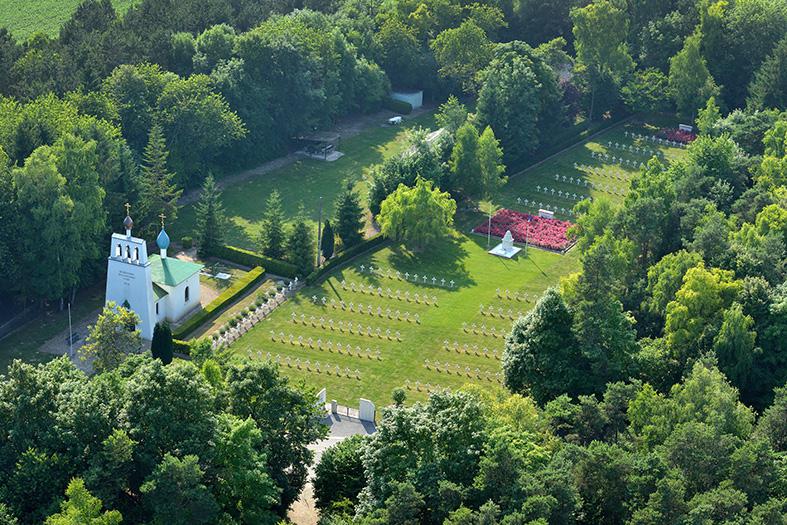



Summary
DATE : 25 April 1915
LIEU : Gallipoli, a Turkish peninsula at the entrance to the Dardanelles Straits
ISSUE : Allied landing
FORCES EN PRÉSENCE : France, United Kingdom, Ottoman Empire
The hecatombs of 1914 surprised and took aback senior army command. Once the front got bogged down, trench warfare turned out to be just as deadly as mobile warfare and did not enable any of the belligerents to gain a decisive upper hand. So how could you do away with the trenches and win this war as quickly as possible?
At the end of 1914, it was no exaggeration to say army command was in disarray. Six months earlier, in August 1914, they went into war full of confidence fully believing in the illusion of a short war and with their heads full of Napoleonic dreams. War was first and foremost a matter of courage, guts, momentum, it was an affair of horse flesh, cavalry charges with sabres out and furious onslaughts by infantry with their bayonets mounted. They were to become disillusioned very quickly and discover that this 19th century model belonged to the past.
Right from the first clashes, the French understood that they had entered the industrial war era, an era of fire-power that made the canon the King of the war and forced the infantry to dig in if they were to withstand the shock without being wiped out. So between October and November, a trench line was formed over 700 km from the North Sea to Switzerland transforming the mobile war into a siege war.
The situation was virtually the same on the eastern front. Even though they were beaten in East Prussia by the Germans, the Russians caused great problems for the Austrian and Hungarian forces and pushed their troops right back to the Carpathians, but here again, the offensive stalled: the lack of ammunition, logistic shortages and the truce called by general winter blocked the situation until spring. So the question that was tormenting army command at the end of 1914 was: how to put an end to this trench warfare? How to overcome this stalemate? How to do away with the barbed wire, artillery barrages and the firing of machine guns that promise defeat to anyone crazy enough to attack? Both camps reflected on how to go beyond this new form of warfare that was still poorly understood, in the search for a new method or a new front that would unblock everything.
In the trenches before the attack, Souain (Marne), September 1915.
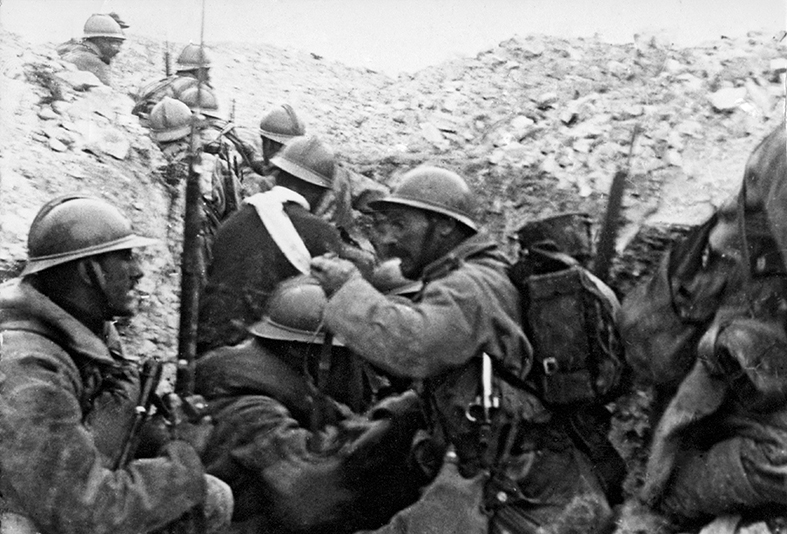
© ECPAD / Victor Chatenay
THE SCHLIEFFEN PLAN IN REVERSE
With the experience of small or large scale offensives, that of the Germans on Calais for example, it soon transpired that defence was superior to offence. Even if you put in every resource you have, sacrificing thousands of men to take the enemy trench, they will just fall back to another second line trench a few hundred metres away and you have to repeat the whole operation again. Also, at the end of 1914, some generals and politicians had understand that if massive and fruitless deaths were to be avoided in 1915, it was necessary to stand back and take a good look at the map of the war. Two considerations were driving these far-sighted individuals who observed the stalemate on the western front: resume the mobile war and since you cannot defeat the strongest, attack the weak.
This debate was the same in France, Great Britain and Germany. In Berlin, in fact, there was always a fear of fighting on two fronts – Russia and France – and so as not to split up its forces, the German army designed the Schlieffen plan which was to quickly overrun France before turning back to fight against Russia, a war that would be longer since it was such a huge country. But The battle of the Marne scuppered this plan. Yes France had been invaded but it had held steady and the German army found itself in the situation it dreaded.
German soldiers in a trench near Ivangorod (Russia), July 1915.
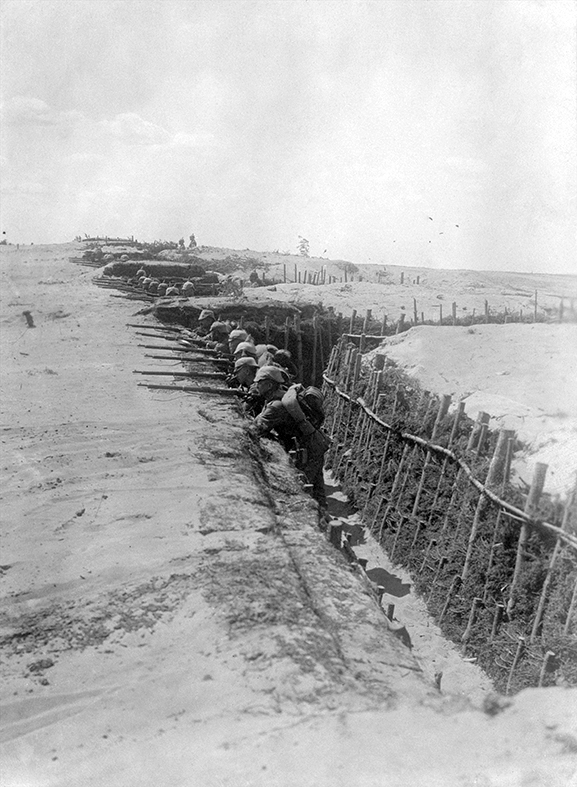
© PA Archive / Roger Viollet
For this reason, a number of strategists, starting with Hindenburg and his quartermaster Ludendorff, leaders on the eastern front, advocated reversing the Schlieffen plan in 1915: stay on the defensive in the West and finish off Russia in the East. The army of Tsar Nicolas II had many soldiers but few guns and it was out of shells; it would therefore be easy to overrun it with a bit of equipment. However the head of the German armies, General Falkenhayn, who had the ear of Emperor Wilhelm II, was opposed to massively redirecting forces to the eastern front. Did not Napoleon come a cropper on Russia? In addition, taking advantage of its vastness, Russian troops could always retreat and force the Germans to hit into a pillow. Under pressure from Marshal Hindenburg, immensely popular since he defeated the Russians in East Prussia, Falkenhayn gave way some terrain in August. Instead of having 80% of German troops on the Western front, he agreed to lower this figure to 60% to given eastern front leaders resources to defeat the Russians.
TAKE THE WAR TO THE BALKANS
In both Paris and London, the same reflections were underway. There was total stalemate in the west and it was unlikely that the Germans could be beaten. So why not look for another theatre of operations in the Balkans, resume a mobile war and defeat the weaker force, namely Austria-Hungary so as to isolate Germany and then attack it on its southern flank? To do this, considerable forces would be needed, at least 500,000 troops in Greece, in Salonica, to go back up through Macedonia and join Serbia which was still holding out against Austria. Finally, together with the Russians, launch a major operation that would crush the Austro-Hungarian forces. On paper, the plan was perfect. Especially since it was as much political as military. Indeed, when the neutral Balkan states saw the likely defeat of the Austro-Hungarian Empire, they would no doubt want to join in the war to get their share of the spoils: Italy, which was eyeing up Trentino and Istria, Romania, who dreamed of seizing Transylvania, would no doubt join in but Bulgaria and Greece would almost certainly do the same. This idea was supported by Generals de Castelnau and Franchet d'Esperey in October 1914, but also by such politicians as Aristide Briand in France and David Lloyd George in Britain.
Austrian troops in the Dardanelles, 1915.
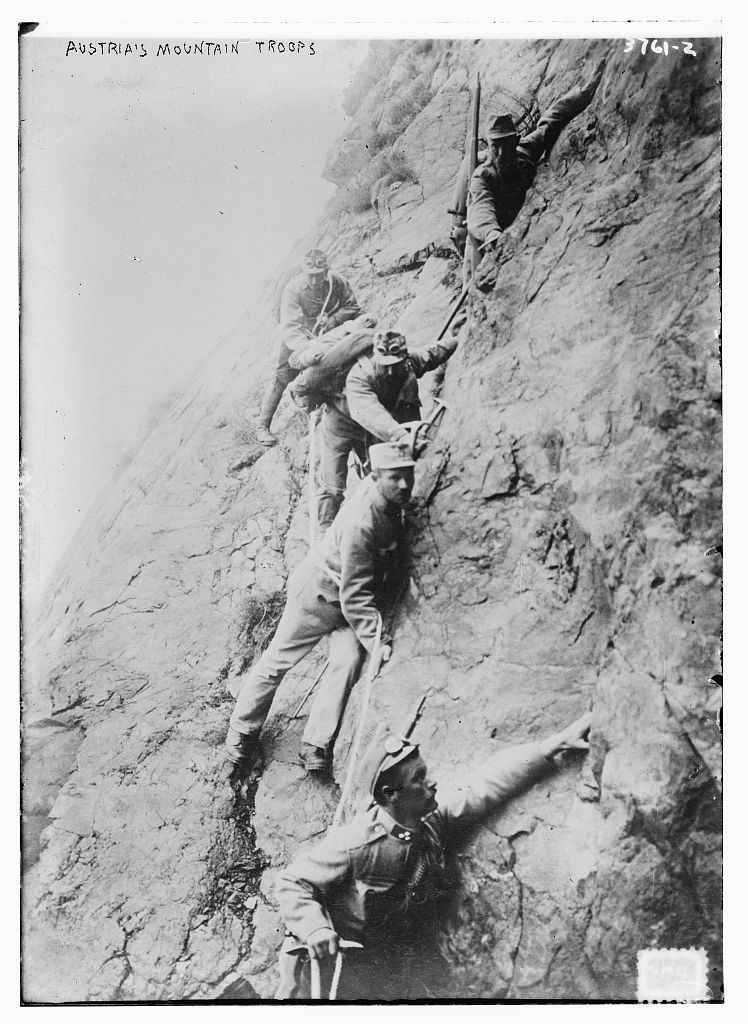
© Library of Congress / George Grantham Bain Collection
But here too there was opposition... and no small opposition either: Lord Kitchener, his Majesty's War Minister, after showing an interest in this project for an army of the Orient that could change the course of the war, changed his mind. There were already not enough men and equipment to supply the western front so he was not about to get involved in a distant and expensive Balkan adventure.
But it was Joseph Joffre, the French Generalissimo, who was the most hostile to the project. He, with his annoying habit of promising victory every three months, was sure he could beat the Germans in the spring and so he needed all the men and guns he could get. And then, beating lowly Austria was a bad idea in his view: "It isn't Austria we have to beat, it's Germany", he cried on 8 January 1915.
A HALF GERMAN VICTORY IN RUSSIA
While Falkenhayn accepted the idea of a major offensive against Russia, he did not have any illusions about the outcome: he did not think Germany could floor the Russians but it could inflict such losses on them that they would agree to sign a separate peace. In any case, there was no question of him strengthening the popularity of the Hindenburg-Ludendorff tandem so he entrusted the offensive to general Mackensen who also commanded the Austrian troops placed alongside the Germans.
British troops on the attack near Achi Baba on the Gallipoli peninsula, 25 April 1915.
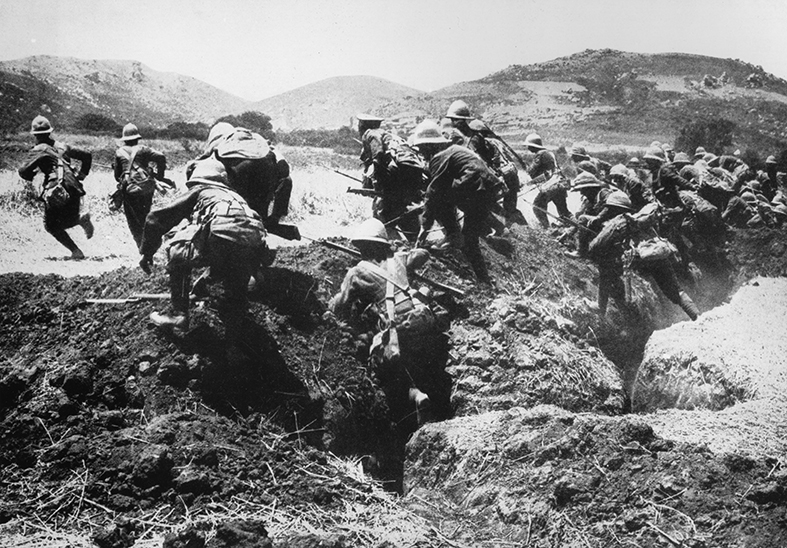
© Akg - images
During the entire month of April, troops were concentrated in the greatest secrecy along a line about 50 kilometres long and over 2,000 guns were put in place with no less than one million shells. Never had such a formidable battle been prepared. On 1 May, the bombardment pounded Russian positions all day long. It was an awesome deluge of fire. The next day, when the assault was ordered, the Russian lines collapsed and Russian soldiers surrendered in droves or ran away as fast as they could. With barely one rifle for every three soldiers, they had good reason to avoid combat! In one month, the Germans took 300,000 prisoners. And nothing seemed to be able to stop Mackensen's advance: the Russian steamroller was no more than a joke. On 4 August, Warsaw was invaded and all of Russian Poland fell into the hands of the Germans. But as they progressed, the Germans were stretching their supply lines while the Russians were tightening theirs.
The offensive ended in September: a lot more men and guns would be needed to march on Petrograd through the Baltic countries. Hindenburg and Ludendorff were crying out for these but Falkenhayn could not grant them their wishes given that the French were preparing a major attack in Champagne and he had to prepare "for a pretty bad time ahead".
This was Germany's dilemma in 1915, forced to fight on two fronts and therefore never able to deal a decisive blow.
Ottoman troops during the Gallipoli campaign, 1915.
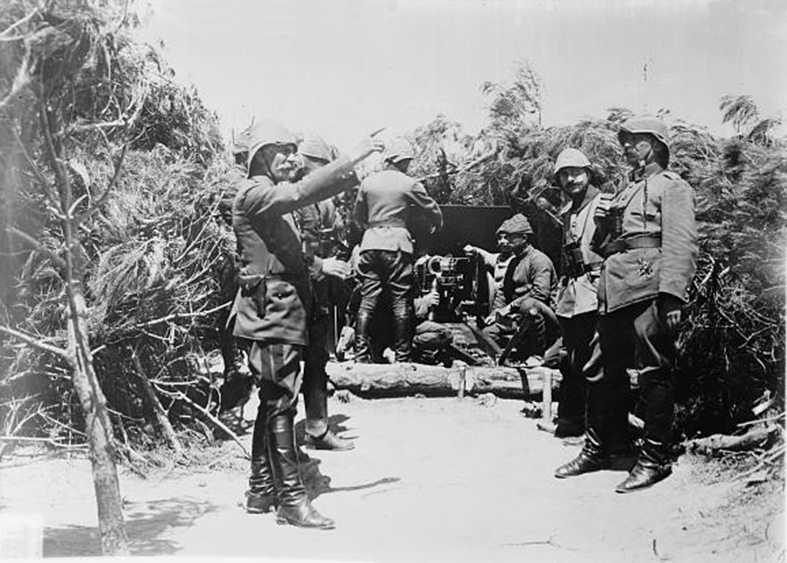
© Library of Congress / George Grantham Bain Collection
THE FALSE GOOD IDEA OF THE DARDANELLES
On the French and English sides, given Joffre and Kitchener's opposition, the idea of an army of the Orient that would fight in the Balkans stalled and got bogged down. Since high command was reluctant, the affair became essentially political. In February, both Governments agreed, for example, on the idea of creating a Franco-British expeditionary force intended to join the Serbian front but opposition was too strong: with France invaded and the Germans barely more than 100 km from the capital, was this the right time to strip the trenches of men and try a wild shot on a front that was as remote as it was secondary? Would public opinion understand that we remain on the defensive in the west and do nothing to repel the invader?
In addition, the Generalissimo was preparing a small offensive "from behind the faggots" that the Germans would remember. So he found the army of the Orient project completely useless if not totally ludicrous. "Why look elsewhere and so far away for what I will get in March 1915? I'm sure to break through and sent the Germans packing." It was in this stalemate situation that Winston Churchill, first lord of the Admiralty, i.e. the Minister of the Navy, presented his own project, a project that competed directly with that of the army of the Orient: force the Turkish Dardanelles Straits and the Bosphorus and seize Constantinople. Since only the Royal Navy was to be involved in this spectacular move and since Churchill was not asking for any additional guns or army regiments, his proposal gained unanimous favour. But the French did not believe it would work. Despite their doubts, they joined in on the operation because were it to be a success, the English must not be allowed to be sole masters of the situation in the Eastern Mediterranean and redraw the map of the Middle East for their own benefit.
French shells being fired on the Gallipoli peninsula, April 1915.

© Akg-images / Gérard Degeorge
On 18 March, a Franco-British armada thus arrived before the Dardanelles for an expedition they believed to be a foregone conclusion. Nothing went as planned. Overseen and equipped by the Germans, the Turks multiplied the batteries and threw drifting mines into the straits. The Allied fleet was unable to cross the Dardanelles. Humiliated, the English and French then had the idea of an amphibious operation and organised a landing on Gallipoli Peninsula on 25 April, with a force of colonial troops (one third of French forces were Senegalese and Australian and New Zealand troops formed the bulk of the British battalions). Since the Turks held the high ground, the operation turned into a bloody fiasco with the same trenches and same stalemate here as on the western front and thirst and mosquitoes thrown in for good measure. In the end, the operation turned out to be very costly in men and material (more than 500,000 troops had been committed to it) and all this with nothing to show for it. The only success of the Dardanelles campaign was the evacuation without losses in December 1915 and January 1916.
TOO LATE FOR THE ARMY OF THE ORIENT
The disastrous Dardanelles adventure had dire consequences: not only did it parasitise the army of the Orient project, which was to land in Greece and join the Serbian front, but it gave second thoughts to the neutral Balkan states. With the exception of Italy who decided to intervene – it signed the Alliance Treaty on 26 April, at a time when it was thought that there could be a victory in the Dardanelles –, Greece and Romania who had been in favour were now suddenly cooling off and returning to a more prudent wait and see attitude. Bulgaria, which had been Pro-German since the Balkan war of 1913 which gave Serbia an advantage at its expense, came out of its reserve when it saw that the French and English were unable to defeat the Ottomans. It then secretly joined the central powers during the summer, and on 5 October, entered the conflict by catching Serbia in a pincer move at a time when Serbia was struggling against a major Austro-German offensive. The Serbian army was beaten and forced to retreat through Albania and the country was fully handed over to the invaders.
At the same time, the governments forced high command to create an army of the Orient to rescue the Serbs. When it landed in Salonica, in October, it was too late: Serbia was already collapsing. What a beautiful idea it was at the beginning of 1915, this idea of the army of the Orient but the delay in setting it up made it completely inoperative. At the end of the year, not only was Serbia wiped off the map but Romania and Greece shrunk back into neutrality while Bulgaria had fallen into the enemy camp: the procrastination by the Allies and their dramatic Dardanelles detour had handed over the Balkans to the central powers.
Docking of a French troop transport ship in Salonika (Greece). 1915.
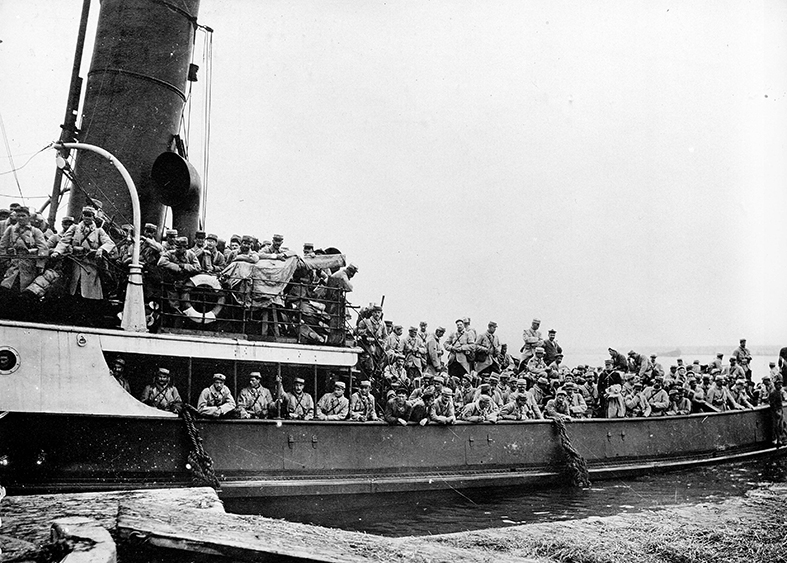
© Roger-Viollet
THE YEAR OF NEEDLESS MASSACRES
If the Army of the Orient project was torpedoed, it was, as we have seen, because Joffre wanted absolutely nothing to do with it. For 1915, he sincerely believed in a breakthrough on the western front, like long needle spikes all along the front, operations with minor objectives or large ramming operations, in Artois and Champagne in the spring, in Champagne and Artois in autumn. As this was not actually happening and that men were dying by the tens of thousands, he justified his strategy by inventing the nibbling theory. In reality, this was the strategy of someone who did not have one and who did not know what to do. Nibbling the enemy's positions in fact meant perpetually attacking them in order to gain a moral ascendancy over the enemy and keep the troops sharp through these regular massacres that had no fundamental objective other than ensuring the men did not lapse into the comfort of staying on the defensive. In fact, the only effect of the nibbling strategy was to wear down the French army and not the Germans.
At the end of 1915, 320,000 soldiers had died for a gain of 3 km in Artois and 5 km in Champagne. Not exactly what you could call an overwhelming success... General Castelnau was right when he sadly observed that "our army has spent all of 1915 wearing its teeth down to the root against a wall." Lloyd George, an early supporter of the Army of the Orient plan was furious at the lack of ingenuity of military command which was always one step behind the enemy: "Too late in moving here. Too late in arriving there. Too late in coming to this decision, too late in starting with enterprises, too late in preparing." Fortunately, Joffre had a plan for 1916. He now swore by coordinating the fronts and did not want to attempt anything until the Russian army has recovered and was in a position to resume the offensive, but he was giving much thought to a huge offensive for the following summer.
In the inter-allied conference at Chantilly, from 6 to 8 December, it was agreed that the French, British, Italians and Russians would attack together around the month of June 1916. A simultaneous operation that would prevent Germany from moving its reserves from one front to another and would result in its defeat. But June 1916 was a long way away and it was very unlikely that the Germans would be polite enough to sit around and wait six months for the Allies to get ready. On the contrary, having nothing to fear from Russia which was licking its wounds, Falkenhayn could safely prepare a deep punch into the western front. His sights were now firmly set on the Verdun salient.
"In the entrenched camp at Salonica": French troops crossing the Galiko, late 1915. Photograph published in the Excelsior newspaper on Sunday 30 January 1916.
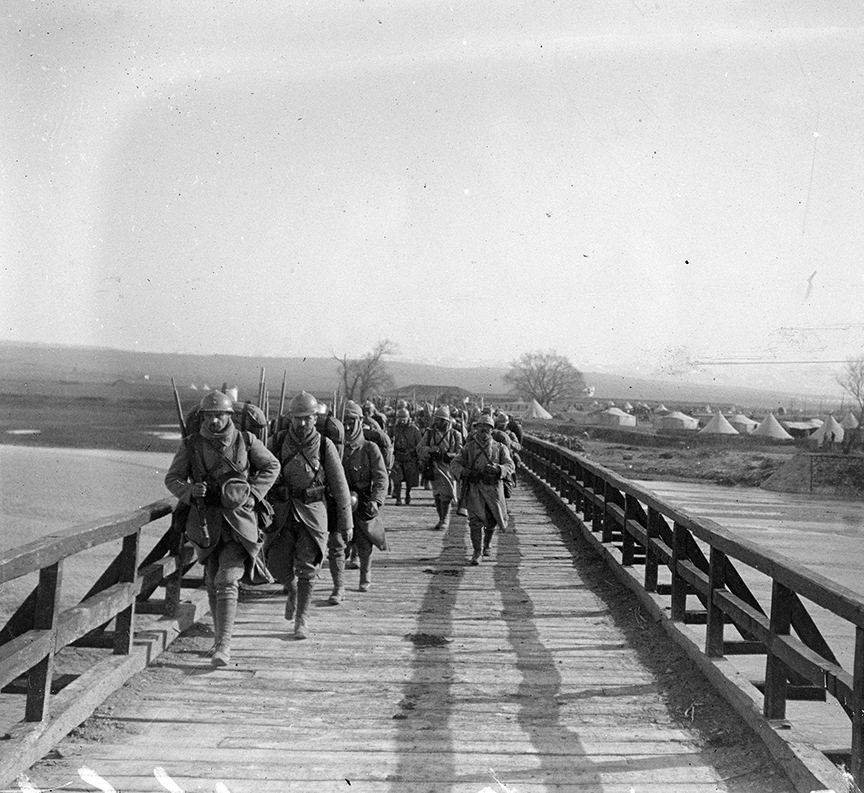
© Caudrilliers / Excelsior - L'Equipe / Roger-Viollet
Author
Jean-Yves Le Naour. First world war historian
Read more
Bibliography :
1915. L'enlisement, Jean-Yves Le Naour, published by Perrin, 2013.
Articles of the review
-
The event
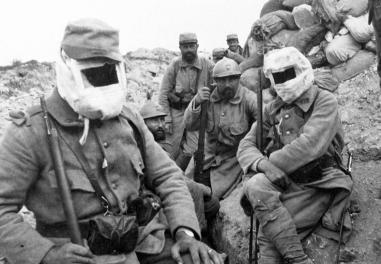
The massive use of poison gas
Read more -
The figure
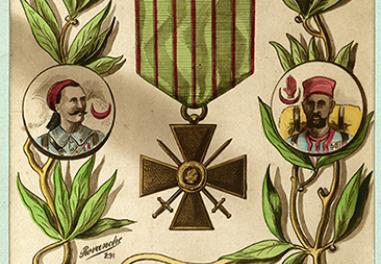
The Croix de Guerre is 100 years old
Right from the first battles in the summer of 1914, a shortcoming was quickly detected in the French system of rewarding deserving combatants. It was not until April 1915 that the Croix de Guerre was created which was then to become the very symbol of victorious First World War soldiers. Vidéo commé...Read more -
The interview

Nicole Buresi
Agrégée (holder of highest teaching diploma in France) in Literature and a playwright, this teacher ran a writer's workshop for six months on the Great War. Nicole Buresi told us about this joint work that culminated with the publication of a novel, Bassoles goes off to war.
Read more


